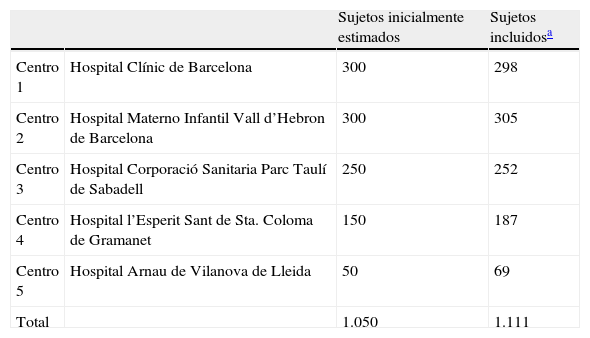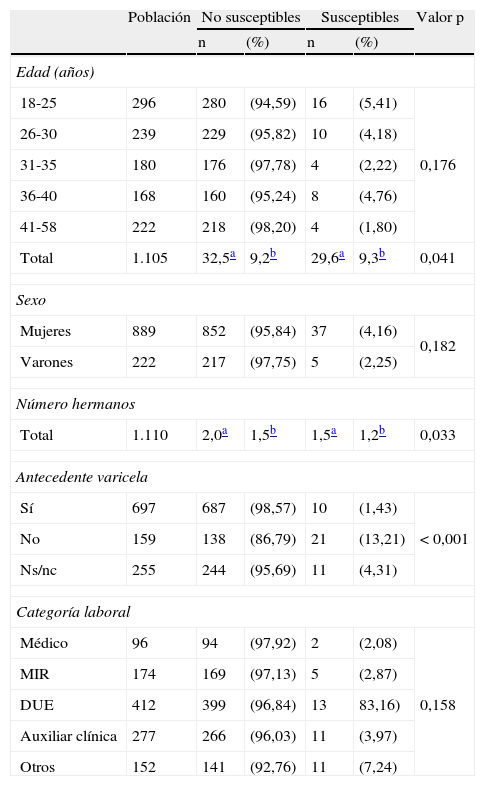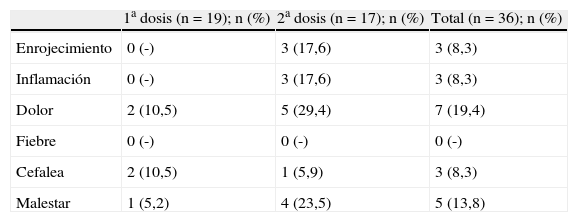Determinar la prevalencia de sujetos susceptibles al virus varicela-zóster (VVZ) en personal sanitario de 5 centros hospitalarios. Como objetivo secundario, describir la inmunogenicidad y reactogenicidad de la vacuna en los sujetos susceptibles.
Sujetos y métodosEstudio multicéntrico transversal analítico realizado en 5 centros hospitalarios de Cataluña. Se incluyeron 1.111 trabajadores sanitarios con edades entre 18-60 años. Se estudió la prevalencia de anticuerpos (IgG) anti-VVZ, y se obtuvieron variables (demográficas, médicas, laborales y antecedentes de varicela) presuntamente relacionadas. Se vacunó a los susceptibles y se estudió la inmunogenicidad (determinación de anticuerpos) y la reactogenicidad de 1 y 2 dosis de vacuna. La determinación de anticuerpos anti-VVZ (IgG) se realizó mediante la técnica de enzimoinmunoensayo. Los resultados negativos posvacunales se confirmaron mediante test de anticuerpos fluorescentes para la detección de la membrana del antígeno (FAMA).
ResultadosCuarenta y dos sujetos (3,8%) resultaron susceptibles. La susceptibilidad al VVZ se asoció (p<0,05) a menor edad (media [DE] de 29,6 [8,5] años frente a 32,5 [9,3] años en los no susceptibles), a un menor número de hermanos y a la ausencia de antecedentes clínicos de varicela. La determinación posvacunal mediante enzimoinmunoanálisis muestra tasas de seroconversión del 52 y del 86% tras la administración de 1 y 2 dosis, respectivamente, y de 100% mediante FAMA. No se registraron acontecimientos adversos importantes.
ConclusionesLa susceptibilidad a la varicela del personal sanitario es baja. El antecedente declarado de padecimiento de varicela es un buen predictor de exposición anterior al VVZ, ya que el 99% (687/696) de los que decían haber padecido la enfermedad eran inmunes. Esto permitiría obviar el cribado prevacunal en casi dos tercios de los sanitarios.
To determine the prevalence of health care workers (HCW) susceptibility to varicella zoster virus (VZV). As a secondary objective, we describe the immunogenicity and reactogenicity of the vaccine.
Subjects and methodsA multicenter analytic cross-sectional study was conducted in 5 hospitals in Catalonia, Spain, in a total of 1,111 HCW, aged between 18-60 years. We studied the prevalence of anti-VZV antibodies (IgG) and obtained demographic, occupational and health related variables that were expected to be associated with immunogenicity, as well as past history of varicella. All susceptible HCW were vaccinated and we studied the immunogenicity (antibody detection) and reactogenicity of the 1st and 2nd doses of the vaccine. Detection of antibodies against VZV was obtained by ELISA. All negative results were confirmed with FAMA.
ResultsForty two subjects (3.8%) were negative. Susceptibility to VZV was associated (p<0.05) with decreased age (29.6 years ± 8.5 vs. 32,5±9,3 in non-susceptible individuals), having fewer siblings and having no previous clinical history of varicella. Postvaccination detection tests with ELISA showed a seroconversion rate of 52 and 86% after the 1st and 2nd doses of the vaccine respectively, and 100% when using FAMA. There were no significant adverse events.
ConclusionsSusceptibility to varicella among HCW is low. Positive past history of varicella is a good predictor of previous exposure to VZV, since 99% (687/696) of the individuals that declared having experienced the disease were immune. This would avoid prevaccination screening in nearly two thirds of HCW.
Artículo
Comprando el artículo el PDF del mismo podrá ser descargado
Precio 19,34 €
Comprar ahora









